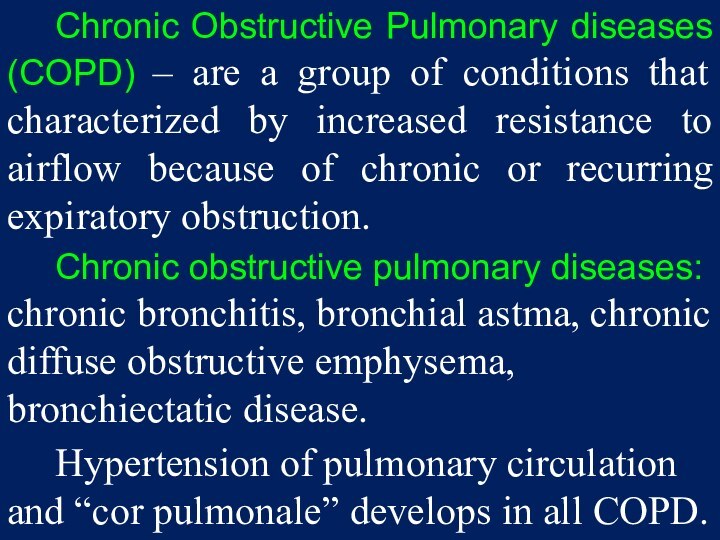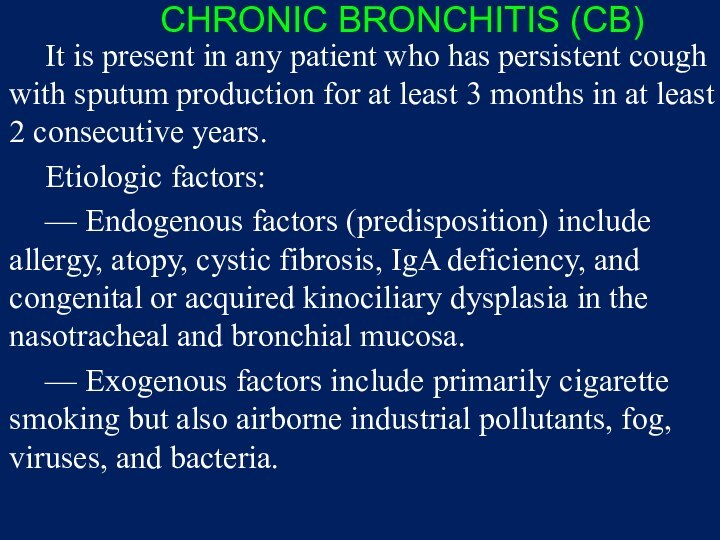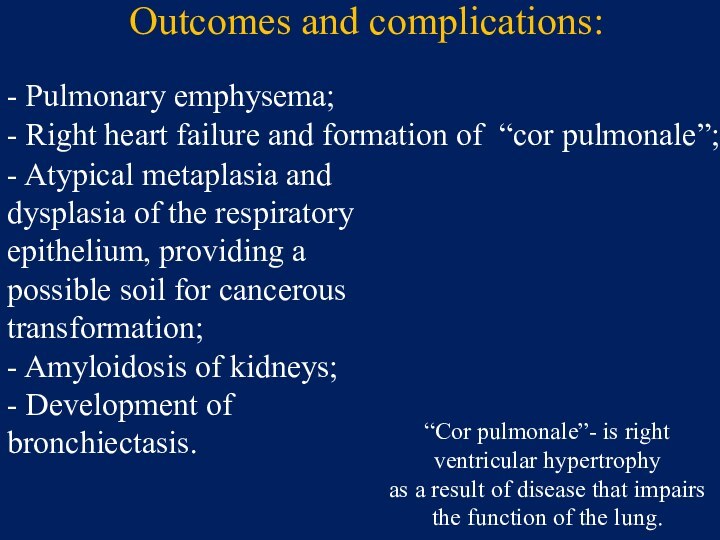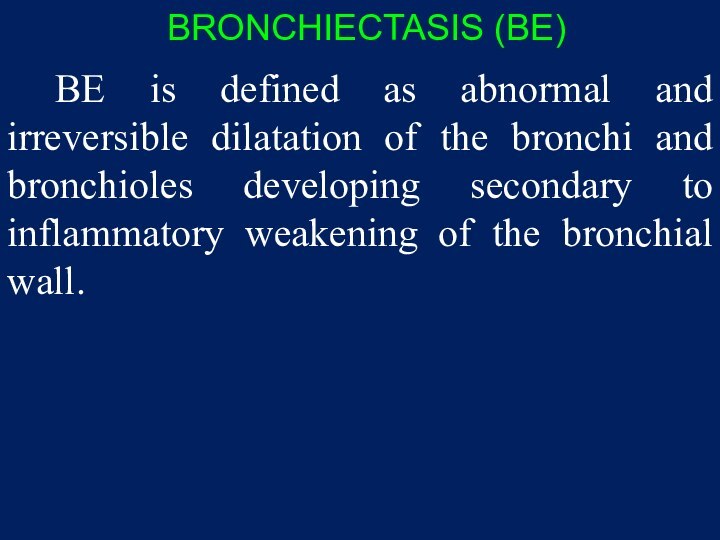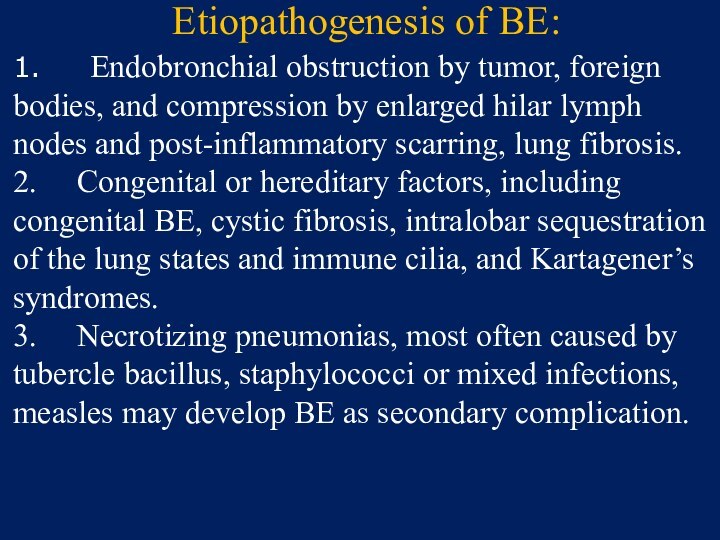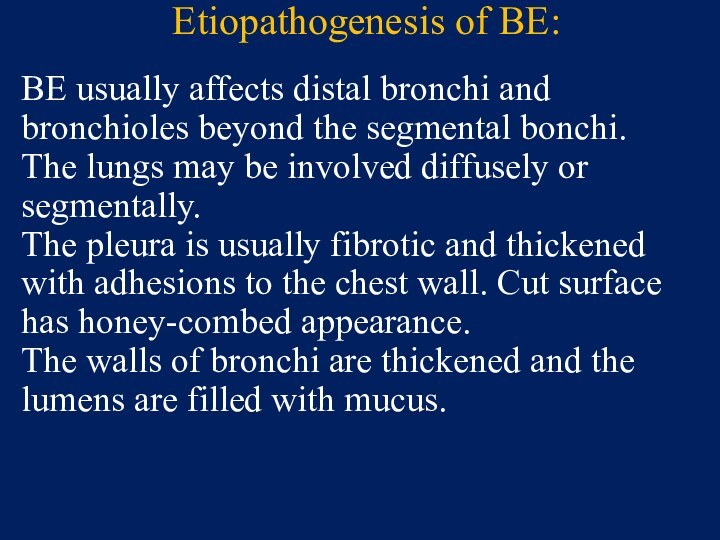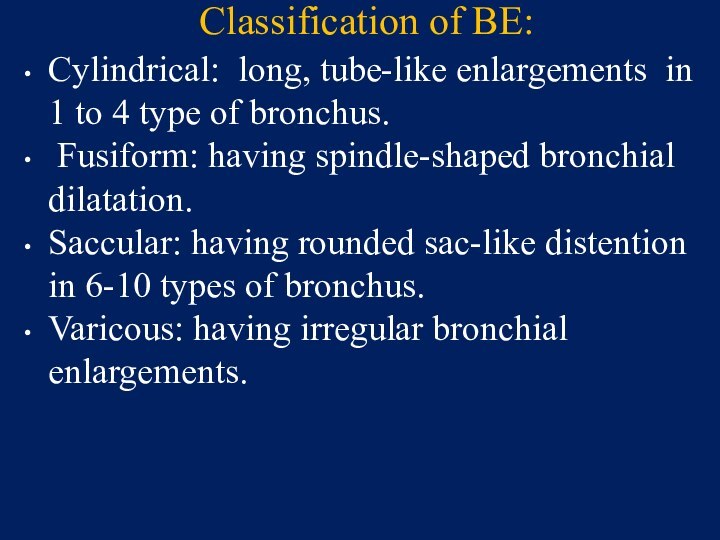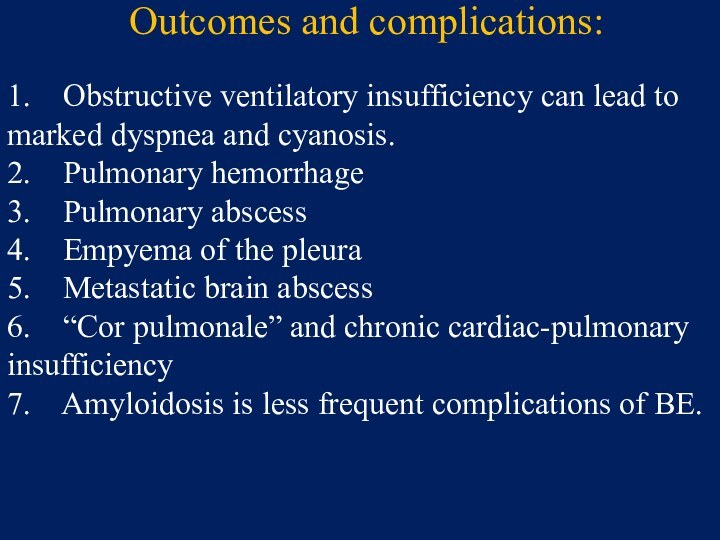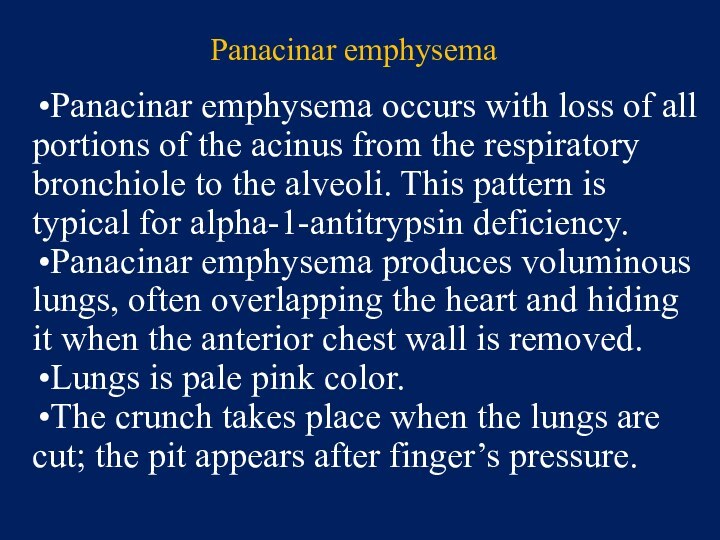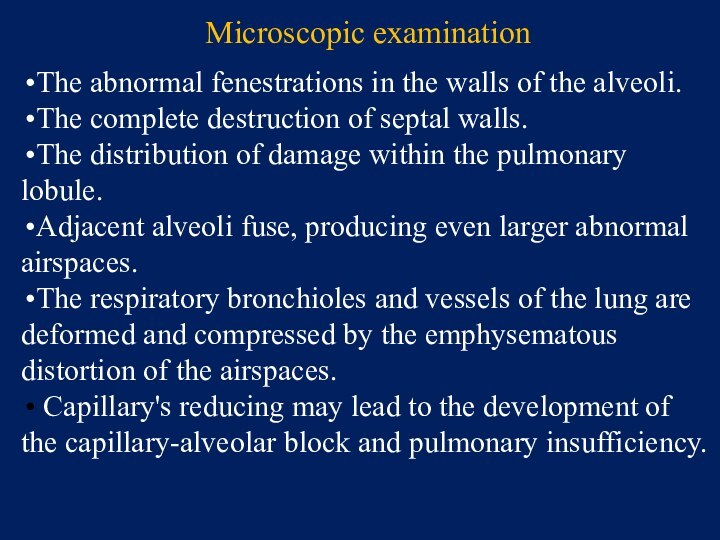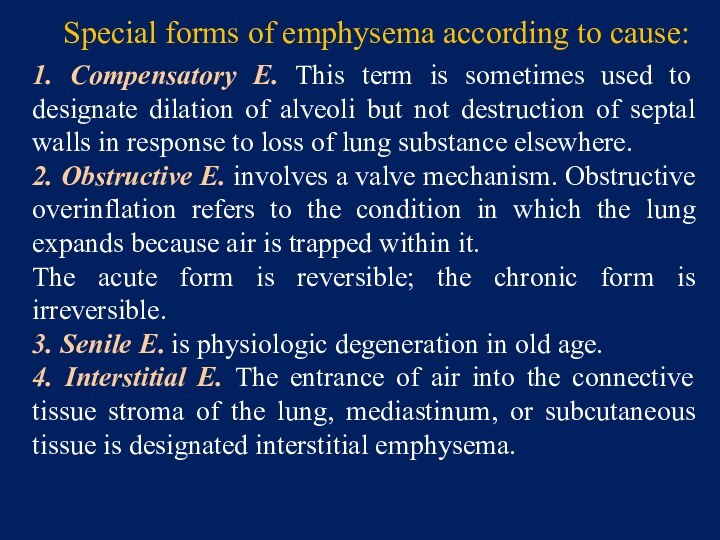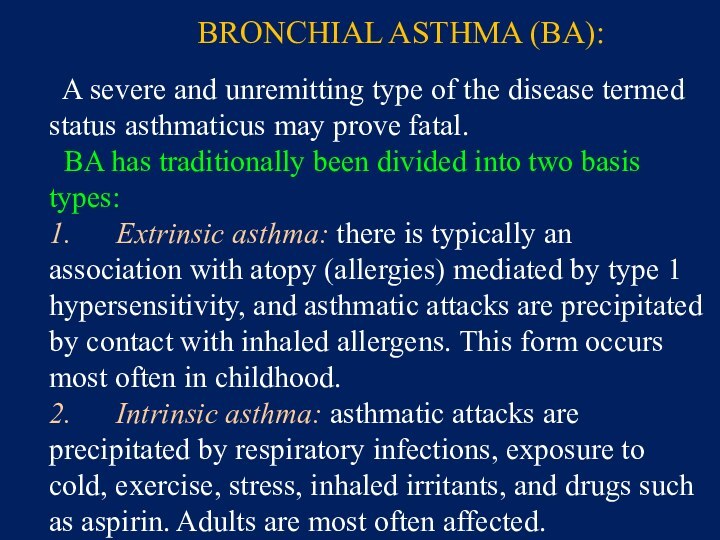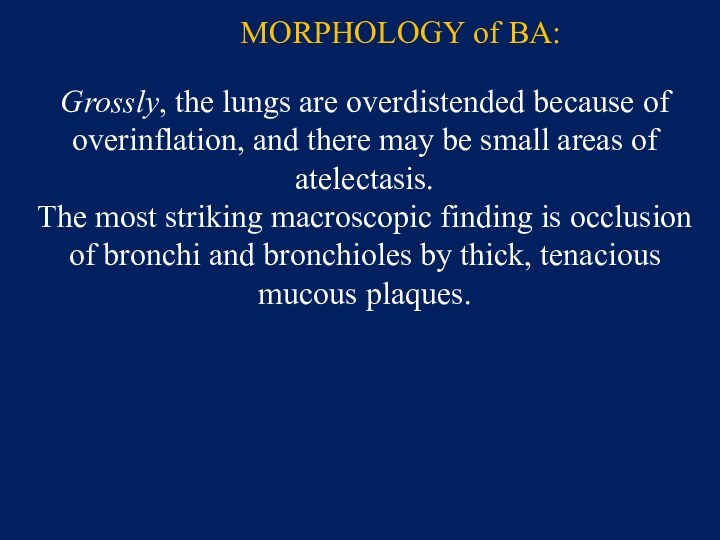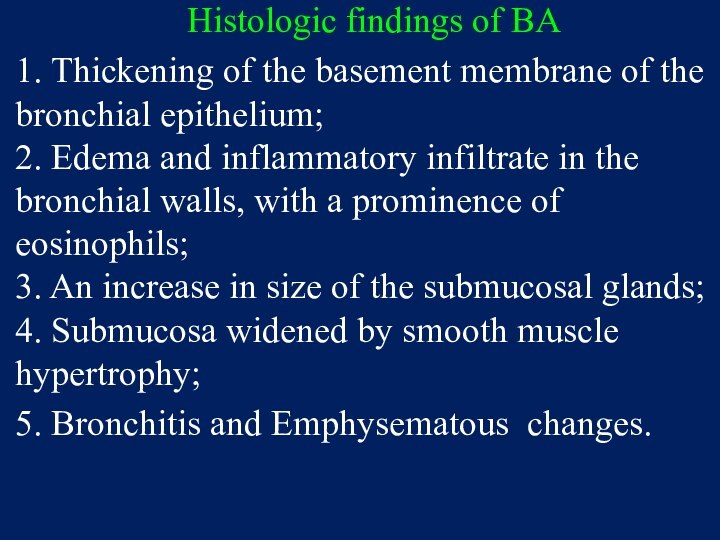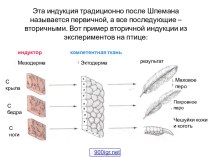Слайд 2
Chronic Obstructive Pulmonary diseases (COPD) – are a
group of conditions that characterized by increased resistance to
airflow because of chronic or recurring expiratory obstruction.
Chronic obstructive pulmonary diseases: chronic bronchitis, bronchial astma, chronic diffuse obstructive emphysema, bronchiectatic disease.
Hypertension of pulmonary circulation and “cor pulmonale” develops in all COPD.
Слайд 3
CHRONIC BRONCHITIS (CB)
It is present in any patient
who has persistent cough with sputum production for at
least 3 months in at least 2 consecutive years.
Etiologic factors:
— Endogenous factors (predisposition) include allergy, atopy, cystic fibrosis, IgA deficiency, and congenital or acquired kinociliary dysplasia in the nasotracheal and bronchial mucosa.
— Exogenous factors include primarily cigarette smoking but also airborne industrial pollutants, fog, viruses, and bacteria.
Слайд 4
Histological features of the airways:
Chronic irritation by inhaled
substances lead to:
replacement of the ciliated epithelia with mucus-secreting
goblet cells (1) in the form of goblet-cell metaplasia;
reactive hypertrophy of the mucus glands in the bronchial wall (2);
excessive mucus production with mucus plugging of the lumen that contributes to airway obstruction;
clustering of pigmented alveolar macrophages;
inflammatory infiltration (3).
fibrosis of bronchiolar wall (4).
Слайд 5
Outcomes and complications:
- Atypical metaplasia and dysplasia of
the respiratory epithelium, providing a possible soil for cancerous
transformation;
- Amyloidosis of kidneys;
- Development of bronchiectasis.
“Cor pulmonale”- is right ventricular hypertrophy
as a result of disease that impairs the function of the lung.
- Pulmonary emphysema;
- Right heart failure and formation of “cor pulmonale”;
Слайд 6
BRONCHIECTASIS (BE)
BE is defined as abnormal and irreversible
dilatation of the bronchi and bronchioles developing secondary to
inflammatory weakening of the bronchial wall.
Слайд 7
Etiopathogenesis of BE:
1. Endobronchial obstruction by tumor, foreign
bodies, and compression by enlarged hilar lymph nodes and
post-inflammatory scarring, lung fibrosis.
2. Congenital or hereditary factors, including congenital BE, cystic fibrosis, intralobar sequestration of the lung states and immune cilia, and Kartagener’s syndromes.
3. Necrotizing pneumonias, most often caused by tubercle bacillus, staphylococci or mixed infections, measles may develop BE as secondary complication.
Слайд 8
Etiopathogenesis of BE:
BE usually affects distal bronchi and
bronchioles beyond the segmental bonchi.
The lungs may be
involved diffusely or segmentally.
The pleura is usually fibrotic and thickened with adhesions to the chest wall. Cut surface has honey-combed appearance.
The walls of bronchi are thickened and the lumens are filled with mucus.
Слайд 9
Classification of BE:
Cylindrical: long, tube-like enlargements in 1
to 4 type of bronchus.
Fusiform: having spindle-shaped
bronchial dilatation.
Saccular: having rounded sac-like distention in 6-10 types of bronchus.
Varicous: having irregular bronchial enlargements.
Слайд 10
The histologic findings of BE:
An intense acute and
chronic inflammatory exudation within the walls of dilated bronchi
and bronchioles. The mucosa and wall is not clearly seen because of the necrotizing inflammation with destruction.
Desquamation of the lining epithelium and extensive areas of necrotizing ulceration.
Squamous metaplasia of the remaining epithelium.
Слайд 11
Outcomes and complications:
1. Obstructive ventilatory insufficiency can lead
to marked dyspnea and cyanosis.
2. Pulmonary hemorrhage
3. Pulmonary abscess
4.
Empyema of the pleura
5. Metastatic brain abscess
6. “Cor pulmonale” and chronic cardiac-pulmonary insufficiency
7. Amyloidosis is less frequent complications of BE.
Слайд 12
EMPHYSEMA
It is a condition of the lung characterized
by abnormal permanent enlargement of the airspace distal to
the terminal bronchiole and destruction of their walls, and without obvious fibrosis.
The fundamental problem is the loss of the lung’s elastic recoil, causing the respiratory bronchioles to collapse upon expiration.
Слайд 13
Pathogenesis of emphysema
Disease is accompanied with destruction of
elastic and collagen fibers of lungs due to action
of leukocytes proteases (in inflammation).
Thus, emphysema is seen to result from the destructive effect of the high protease activity in subjects with low antiprotease activity.
The protease-antiprotease disturbance may also be explained by the deleterious effect of cigarette smoking.
Main pathogenic mechanism is genetically determined deficiency of alpha-1-Antitripsin.
Слайд 14
Classification of emphysema:
The following forms are differentiated according
to the affected section of the pulmonary acinus:
Centriacinar (cenrolobular)
emphysema
Panacinar emphysema
Bullous emphysema
Types of emphysema according to cause:
Obstructive emphysema
Compensatory emphysema
Senile emphysema
Interstitial emphysema
Слайд 15
Centriacinar (cenrolobular) emphysema
The distinctive feature of this
type is the pattern of involvement of the lobules;
the central or proximal parts of the acini, formed by respiratory bronchioles, are affected, whereas distal alveoli are spared.
The walls of the emphysematous spaces often contain large amount of black pigment.
Moderate-to-severe degrees of emphysema occur predominantly in heavy smokers and coal workers’ pneumoconiosis , often in association with chronic bronchitis.
Слайд 16
Panacinar emphysema
Panacinar emphysema occurs with loss of all
portions of the acinus from the respiratory bronchiole to
the alveoli. This pattern is typical for alpha-1-antitrypsin deficiency.
Panacinar emphysema produces voluminous lungs, often overlapping the heart and hiding it when the anterior chest wall is removed.
Lungs is pale pink color.
The crunch takes place when the lungs are cut; the pit appears after finger’s pressure.
Слайд 17
Bullous emphysema
The chest cavity is opened at
autopsy to reveal numerous large bullae apparent on the
surface of the lungs in a patient dying with emphysema. Bullae are large dilated airspaces that bulge out from beneath the pleura.
Emphysema is characterized by a loss of lung parenchyma by destruction of alveoli so that there is permanent dilation of airspaces.
Слайд 18
Microscopic examination
The abnormal fenestrations in the walls of
the alveoli.
The complete destruction of septal walls.
The distribution of
damage within the pulmonary lobule.
Adjacent alveoli fuse, producing even larger abnormal airspaces.
The respiratory bronchioles and vessels of the lung are deformed and compressed by the emphysematous distortion of the airspaces.
Capillary's reducing may lead to the development of the capillary-alveolar block and pulmonary insufficiency.
Слайд 19
Special forms of emphysema according to cause:
1. Compensatory
E. This term is sometimes used to designate dilation
of alveoli but not destruction of septal walls in response to loss of lung substance elsewhere.
2. Obstructive E. involves a valve mechanism. Obstructive overinflation refers to the condition in which the lung expands because air is trapped within it.
The acute form is reversible; the chronic form is irreversible.
3. Senile E. is physiologic degeneration in old age.
4. Interstitial E. The entrance of air into the connective tissue stroma of the lung, mediastinum, or subcutaneous tissue is designated interstitial emphysema.
Слайд 20
Asthma is a disease of airways that is
characterized by increased responsiveness of the tracheobronchial tree to
a variety of stimuli resulting in widespread spasmodic narrowing of the air passages which may be relieved spontaneously or by therapy.
BRONCHIAL ASTHMA (BA)
Слайд 21
BRONCHIAL ASTHMA (BA):
A severe and unremitting type
of the disease termed status asthmaticus may prove fatal.
BA has traditionally been divided into two basis types:
1. Extrinsic asthma: there is typically an association with atopy (allergies) mediated by type 1 hypersensitivity, and asthmatic attacks are precipitated by contact with inhaled allergens. This form occurs most often in childhood.
2. Intrinsic asthma: asthmatic attacks are precipitated by respiratory infections, exposure to cold, exercise, stress, inhaled irritants, and drugs such as aspirin. Adults are most often affected.
Слайд 22
PATHOGENESIS of BA:
Chronic airway inflammation involving many cell
types and inflammatory mediators accompanies the bronchial hyper-responsiveness of
asthma.
Nevertheless, the relationship of the inflammatory cells and their mediators to airway hyper-reactivity is not fully understood.
Слайд 23
MORPHOLOGY of BA:
Grossly, the lungs are overdistended because
of overinflation, and there may be small areas of
atelectasis.
The most striking macroscopic finding is occlusion of bronchi and bronchioles by thick, tenacious mucous plaques.
Слайд 24
Histologic findings of BA
1. Thickening of the basement
membrane of the bronchial epithelium;
2. Edema and inflammatory infiltrate
in the bronchial walls, with a prominence of eosinophils;
3. An increase in size of the submucosal glands;
4. Submucosa widened by smooth muscle hypertrophy;
5. Bronchitis and Emphysematous changes.
Слайд 25
The classic asthmatic attack lasts up to several
hours and is followed by prolonged coughing; the raising
of copious mucous secretions provides considerable relief of the respiratory difficulty. In some patients, these symptoms persist at a low level all the time. In its most severe form, status asthmaticus, the severe acute paroxysm
persists for days and even weeks, and, under these circumstances, ventilatory function may be so impaired
as to cause severe cyanosis
and even death.
Слайд 26
IDIOPATHIC PULMONARY FIBROSIS
Diffuse interstitial fibrosis occurs as a
result of different pulmonary diseases such as pneumoconiosis, hypersensitivity
pneumonitis (“farmer's lung”, “bird fancier's disease”, “silo filler's disease”) and collagen-vascular disease. It is so called “idiopathic pulmonary fibrosis” or “cryptogenic fibrosing alveolitis” or “chronic interstitial pneumonitis”
Слайд 27
PATHOGENESIS
The pathogenesis of idiopathic pulmonary fibrosis is
unknown and the condition is diagnosed by excluding all
known causes of interstitial fibrosis:
- High levels of autoantibodies such as rheumatoid factor and antinuclear antibodies.
- Elevated titres of circulating immune complexes.
- Immunofluorescent demonstration of the deposits of immunoglobulins and complement on the alveolar walls in biopsy specimens.
Слайд 28
MORPHOLOGY:
Pathological changes are bilateral and widespread.
· Macroscopically the
lungs are dense, reduced volume.
· Honey-combing (i.e. enlarged, thick-walled
air spaces) develops in parts of lung. Microscopically, changes vary according to the stage of the disease with formation of hyaline membranes.
· There is edema and cellular infiltrate in the alveolar septa in early stage.
· There is organization of the alveolar exudate and replacement fibrosis in the alveoli and in the interstitial septal wall with variable amount of inflammation in advanced stage.
Слайд 29
HYPERSENSITIVITY PNEUMONITIS
Hypersensitivity pneumonitis occur when there is
an inhaled organic dust that produces a localized for
of type III hypersensitivity (Arthus) reaction from antigen-antibody complexes.
Alveolar wall is enlarged with chronic inflammatory cells and giant cells

